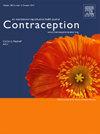德克萨斯州 SB 8 号堕胎禁令对科罗拉多州一家大型诊所堕胎时怀孕时间的影响。
IF 2.8
2区 医学
Q1 OBSTETRICS & GYNECOLOGY
引用次数: 0
摘要
目标:评估德克萨斯州通过第 8 号参议院法案(SB 8)禁止在可检测到胚胎心脏活动后进行人工流产后,科罗拉多州丹佛市一所大学附属诊所的人工流产类型、妊娠时间以及外州居民比例的变化:我们审查了 2019 年 1 月至 2022 年 6 月期间妊娠期≤22w6d 的所有人工流产患者的就诊记录。我们创建了两个时间段:SB 8 之前(2019 年 1 月至 2021 年 8 月)和 SB 8 之后(2021 年 9 月至 2022 年 6 月)。我们评估了流产类型、妊娠时间和外州居民比例的变化。我们使用逻辑回归模型确定了 SB 8 后第二孕期流产(≥13w0d)的几率,并对孕酮、胎次、年龄和外州居民比例进行了调整:结果:共有 3,844 例人工流产:结果:共有 3,844 例堕胎:SB 8 之前为 2,875 例,SB 8 之后为 969 例。科罗拉多州居民的第二孕期堕胎率从 16.8% 增加到 24.4%,州外居民的第二孕期堕胎率从 19.5% 增加到 33.5%(p 结论:禁止早期堕胎的法律会降低堕胎率:禁止孕早期堕胎的法律不仅会延误妊娠后期的护理,而且会增加妊娠后期的堕胎率,这不仅是对被迫到州外寻求护理的人而言,也是对可获得堕胎服务的各州居民而言:我们的数据表明,禁止堕胎可能会增加等待时间和妊娠时间,并迫使人们长途跋涉寻求治疗。随着越来越多的州禁止堕胎或限制堕胎,堕胎受到保护的周边州可能需要满足本州居民和旅行者的需求。本文章由计算机程序翻译,如有差异,请以英文原文为准。
The impact of the SB 8 Texas abortion ban on pregnancy duration at time of abortion in a large volume Colorado clinic
Objectives
To assess changes in type of abortion, gestational duration, and changes in the proportion of out-of-state residents at a university-affiliated clinic in Denver, Colorado after Texas passed Senate Bill 8 (SB 8) that banned abortion after embryonic cardiac activity can be detected.
Study design
We reviewed records of all visits of patients obtaining an abortion ≤22 weeks and 6 days gestation between January 2019 and June 2022. We created two time periods: before SB 8 (January 2019–August 2021) and after SB 8 (September 2021–June 2022). We assessed changes in type of abortion, gestational duration, and the proportion of out-of-state residents. We determined the odds of a second-trimester abortion (≥13 weeks and 0 day) after SB 8 using logistic regression models adjusted for gravida, parity, age, and the proportion of out-of-state residents.
Results
There were 3844 abortions: 2875 before and 969 after SB 8. Second trimester abortions increased from 16.8% to 24.4% for Colorado residents and from 19.5% to 33.5% for out-of-state residents (p < 0.001). The proportion of patients that were Texas residents increased from 1.2% to 17.7% after SB 8 (p < 0.001). The adjusted odds of a second trimester abortion nearly doubled overall (adjusted odds ratio [aOR] 1.86 95% CI 1.55–2.23) and for Colorado residents (aOR,1.76, 95% CI, 1.44–2.16, respectively), and more than doubled for out-of-state residents (aOR, 2.34, 95% CI,1.53–3.59).
Conclusions
Laws that ban abortion early in pregnancy delay care and increase abortions occurring later in pregnancy, not only for people forced to seek care out of state, but for residents of states with abortion access.
Implications
Our data suggests that abortion bans may increase wait times, gestational duration, and force people to travel great distances for care. As more states ban abortion or restrict abortion, surrounding states where abortion is protected may need to meet the needs of those traveling in addition to their in-state residents.
求助全文
通过发布文献求助,成功后即可免费获取论文全文。
去求助
来源期刊

Contraception
医学-妇产科学
CiteScore
4.70
自引率
17.20%
发文量
211
审稿时长
69 days
期刊介绍:
Contraception has an open access mirror journal Contraception: X, sharing the same aims and scope, editorial team, submission system and rigorous peer review.
The journal Contraception wishes to advance reproductive health through the rapid publication of the best and most interesting new scholarship regarding contraception and related fields such as abortion. The journal welcomes manuscripts from investigators working in the laboratory, clinical and social sciences, as well as public health and health professions education.
 求助内容:
求助内容: 应助结果提醒方式:
应助结果提醒方式:


